Gardening is a healthy and enjoyable hobby that comes with a multitude of benefits. Whether you’re a beginner or an experienced gardener, there are various gardening tips that can help you create a thriving garden.
Choosing the Right Plants
Selecting the right plants is essential for gardening success. Consider the different types of plants suitable for beginners, such as annuals, perennials, and biennials. Each type has its own requirements in terms of sunlight, water, and soil conditions. By understanding these requirements, you can ensure that your plants thrive and flourish.
Preparing the Soil
Preparing the soil is a crucial step in creating a successful garden. Conducting a soil test can provide valuable insights into the nutrient levels and pH balance of your soil. Based on the results, you can make informed decisions about soil amendments, such as compost and organic matter, to enrich the soil and create an ideal environment for your plants. Good drainage is also essential for healthy plant growth, so consider incorporating organic matter or sand into the soil and avoid overwatering.
Key Takeaways:
- Choose plants that are suitable for your level of gardening experience.
- Conduct a soil test to determine the nutrient levels and pH balance of your soil.
- Use soil amendments such as compost and organic matter to enrich the soil and create an ideal environment for your plants.
Getting Started with Plant Gardening
If you’re new to plant gardening, it’s essential to start with the basics. To begin, choose plants that are suitable for your garden’s conditions and your experience level. Annuals like marigolds and zinnias are easy to grow and ideal for beginners. Perennials like daylilies and hostas are hardy and often come back year after year, making them low-maintenance options. Biennials like foxgloves and hollyhocks have a two-year growth cycle and can add visual interest to your garden.
Soil preparation is crucial to successful plant gardening. Start by testing your soil to determine nutrient levels and pH balance. Many garden centers offer soil testing kits that can help you determine if your soil requires amendments. Soil amendments like compost, organic matter, and peat moss can improve soil fertility and drainage, making it easier for plants to establish themselves.
| Soil Testing Tips: | Soil Amendment Tips: |
|---|---|
| Test soil in the spring or fall for the most accurate results. | Before adding any amendments, make sure to read the instructions and follow them carefully. |
| Use a soil test kit or send a soil sample to a reputable soil testing lab for analysis. | Spread amendments evenly over the soil surface and mix well with a garden fork. |
| Adjust soil pH levels by adding lime to raise pH or sulfur to lower pH. | Add organic matter like compost, peat moss, or well-rotted manure to improve soil fertility and aeration. |
Planting techniques for seeds, seedlings, and potted plants should be learned, along with watering, maintenance, fertilization, pruning, and pest control. It’s important to follow each plant’s specific care instructions as they can vary. For instance, some plants require frequent watering while others prefer drier soil. Similarly, some plants may need regular pruning to maintain their shape, while others do best when left to grow naturally.
Other spring gardening tasks include pruning, weeding, mulching, and cleaning/maintaining gardening tools. Pruning can help control plant growth and improve their overall appearance. Weeding is essential to remove unwanted plants that compete with your desirable plants for water and nutrients. Mulching can help regulate soil temperature, prevent weeds from growing, and maintain soil moisture levels. Lastly, cleaning and maintaining your gardening tools ensures that they are in good working order when you need them.
Proper planning, choosing the right plants, having good gardening tools, and tending to the garden regularly can lead to a beautiful and successful gardening experience. With patience and practice, you’ll soon be on your way to becoming a plant gardening expert.
Plant Care and Maintenance
Taking care of your plants is crucial to their overall health and growth. Proper maintenance requires attention to several factors, including fertilization, pruning, and pest control. One important aspect of plant care is ensuring adequate water supply. Watering techniques will vary depending on the type of plant and soil conditions.
Fertilization is essential for healthy plant growth. A soil test can determine if there are any nutrient deficiencies, and fertilizers can be added as needed. It is important to read and follow the instructions carefully to avoid over-fertilizing, which can lead to plant damage.
| Maintenance Tips | Fertilization | Pruning | Pest Control |
|---|---|---|---|
| Watering: Deep watering once a week is better than frequent shallow watering. Use a drip irrigation system or a soaker hose to avoid wetting foliage, which can lead to disease. | Soil Test: Determine nutrient levels and pH balance to determine what fertilizers are needed. | Timing: Prune in the early spring before new growth appears or in the fall after leaves have dropped. Remove any dead or diseased branches, and thin out crowded areas. | Prevention: Regularly inspect plants for signs of pests and disease, and take action immediately to prevent spread. Use environmentally friendly methods, such as companion planting or introducing natural predators. |
Regular pruning is also important for maintaining healthy plants. Timing is key, and it is best to prune in the early spring before new growth or in the fall after leaves have dropped. This helps to remove any dead or diseased branches and thin out crowded areas.
Pest control is another critical aspect of plant care. Regularly inspect plants for signs of pests and disease, and take action immediately to prevent spread. Environmentally friendly methods, such as companion planting or introducing natural predators, are preferred over chemical pesticides.
Overall, proper plant care and maintenance are essential to the success of any garden. By paying attention to watering techniques, fertilization, pruning, pest control, and soil conditions, gardeners can ensure the health and vitality of their plants throughout the growing season.
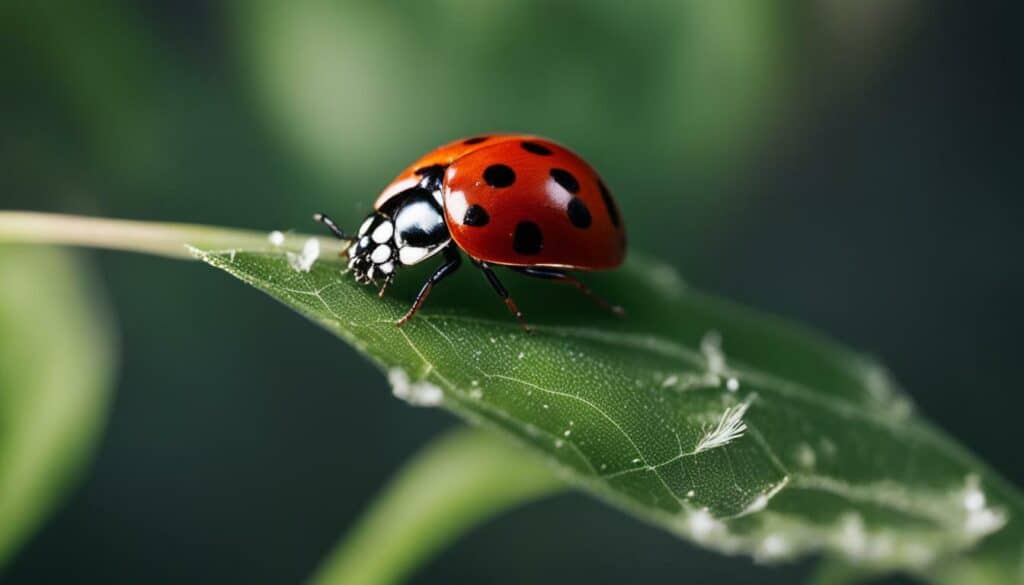
Spring Garden Jobs
As the weather warms up, it’s time to roll up your sleeves and get your hands dirty in the garden. Spring is the perfect time to take on various garden jobs to ensure a successful and thriving garden. Here are some essential tasks to tackle during this season:
| Task | Description |
|---|---|
| Pruning | Prune shrubs and trees before new growth appears. This helps to shape them and remove any dead or damaged branches. |
| Weeding | Remove any weeds before they have a chance to take over your garden. Organic gardening and sustainable gardening practices suggest hand weeding, but you can use herbicides if needed. |
| Mulching | Add a layer of mulch around your plants to help retain moisture in the soil and suppress weed growth. Use organic mulch like wood chips, straw or leaves. |
| Planting | Spring is a great time to plant annuals and perennials. Choose plants that are appropriate for your growing zone and sun exposure. Ensure proper spacing between plants for adequate growing room. |
| Cleaning and maintaining gardening tools | After a long winter, your gardening tools may need some cleaning and maintenance. Sharpen blades, oil moving parts, and clean off any dirt and rust to ensure they are in good shape for the season. |
By completing these tasks, you will be setting your garden up for success in the coming months. Don’t forget to take breaks and enjoy the beauty of your hard work.
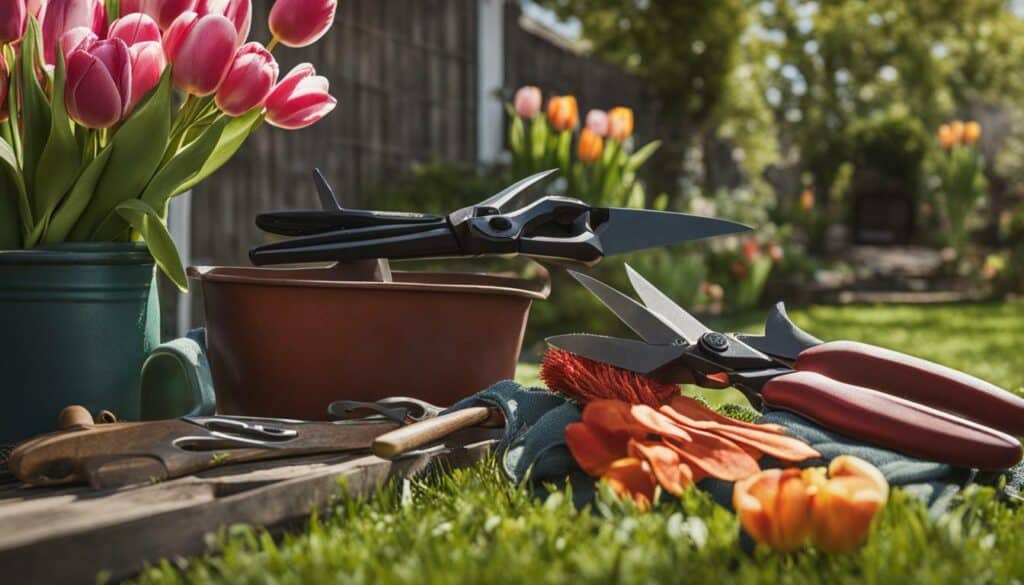
Choosing the Right Plants
With so many plant species available, choosing the right ones for your garden can be overwhelming. However, picking the right plants is crucial for successful gardening, especially for beginners.
To start, consider the type of plant you would like to grow. Are you interested in flowers, vegetables, or herbs? It is important to choose plants that will thrive in your garden’s specific conditions. These conditions include factors such as sunlight exposure, water availability, and soil type and quality. Make sure to read the plant labels or do research to determine each plant’s individual requirements.
It is also important to consider the lifespan of the plant. Annuals, which grow and flower for one season, need to be replanted each year, while perennials return year after year. Some plants, called biennials, live for two growing seasons. Take into account the lifespan of the plant when selecting what to grow.
Once you have chosen your plants, it is crucial to prepare the soil properly to provide the optimal conditions for them to thrive. Conducting a soil test to determine the nutrient levels and pH balance of the soil can help you make informed decisions on fertilization and soil amendments. Common soil amendments include compost, manure, peat moss, and leaf mold, which help improve soil quality.
When it is time to plant, it is important to follow proper planting techniques such as ensuring plants are placed in the correct depth and spacing them appropriately. Ongoing care such as watering, maintenance, fertilizing, pruning, and pest control should also be provided to ensure the garden’s success.
Remember to also incorporate other garden tasks such as pruning, weeding, mulching, planting, and cleaning and maintaining gardening equipment. These tasks will help keep your garden healthy and beautiful all season long.

Essential Gardening Tools
To ensure your plant gardening endeavors are successful, you’ll need a few essential tools. These tools are the backbone of every gardener’s kit and can help make the process of growing and maintaining plants easier and more efficient. Basic tools such as shovels, hand trowels, bypass pruners, gloves, and watering cans are a must-have for every gardener.
When choosing gardening tools, look for high-quality options that are sturdy and durable. Investing in good tools can make a big difference in the long run and save you time and money.
Alongside these basic tools, there are other gardening tools that can help enhance the growth of your plants and keep your garden thriving. These include:
| Gardening Tool | Use |
|---|---|
| Pruning Saw | Used for pruning larger branches on trees and bushes. |
| Hoe | Used for weeding and breaking up soil. |
| Hand Rake | Used for clearing leaves and debris from your garden bed. |
| Wheelbarrow | Used for transporting soil, compost, and other heavy items. |
It’s important to keep your gardening tools clean and in good condition to ensure they last longer. After every use, wipe down your tools with a damp cloth and store them in a dry location. Regular sharpening of pruning tools like shears and saws is also important to ensure they are working effectively when you need them.
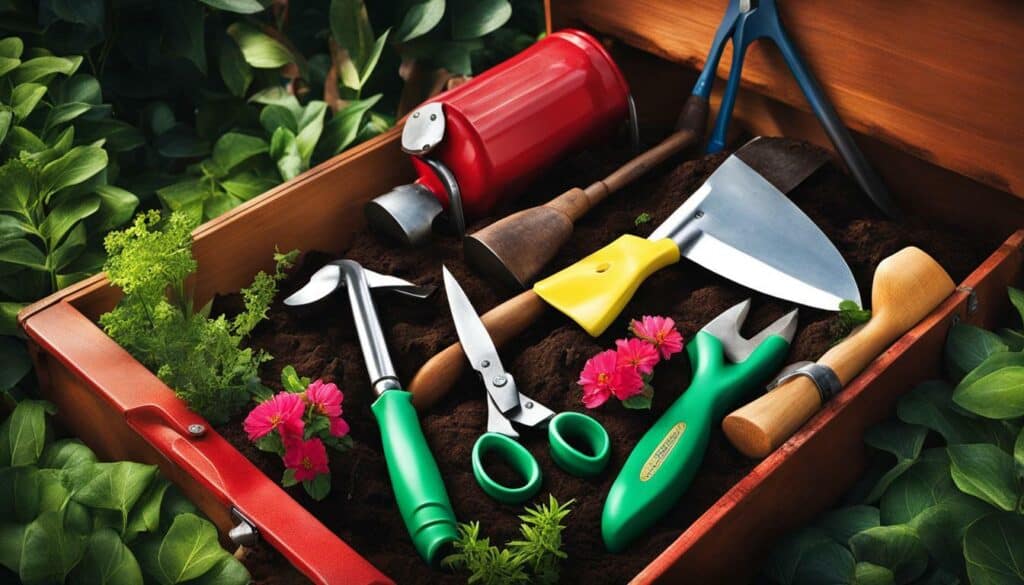
With the right gardening tools and a little bit of know-how, you can create a beautiful and healthy garden that will thrive for years to come. Happy gardening!
Preparing the Soil for Planting
The foundation of a thriving garden starts with properly prepared soil. Before planting, it’s important to test the soil’s nutrient levels and pH balance. This will help you determine which organic matter and soil amendments, such as compost, to add to improve soil fertility and structure.
Good drainage is essential for healthy plant growth, so make sure the soil is well-draining. If not, add sand or perlite to the soil to improve drainage. Adding mulch can also help retain moisture and suppress weed growth.
| Tip: | Add organic matter and soil amendments, like compost, to improve soil fertility and structure. |
|---|---|
| Tip: | Ensure good drainage by adding sand or perlite to the soil. |
| Tip: | Maintain moisture and suppress weed growth with mulch. |
Choosing the right plants for your garden is also essential. Consider the amount of sunlight, water, and soil conditions required for each plant. When planting, make sure to add compost and fertilizers to the soil and plant correctly. Provide adequate water and sunlight to promote healthy growth.
Regular maintenance such as pruning and weeding is necessary for a thriving garden. Removing dead or damaged leaves and branches will help prevent pest and disease issues. Weeding regularly also helps keep your garden healthy and reduces competition for water and nutrients.
Finally, clean and maintain your gardening tools after every use. This will help prolong their longevity and ensure efficient use for future gardening tasks.
Keyword: prepare the soil for planting
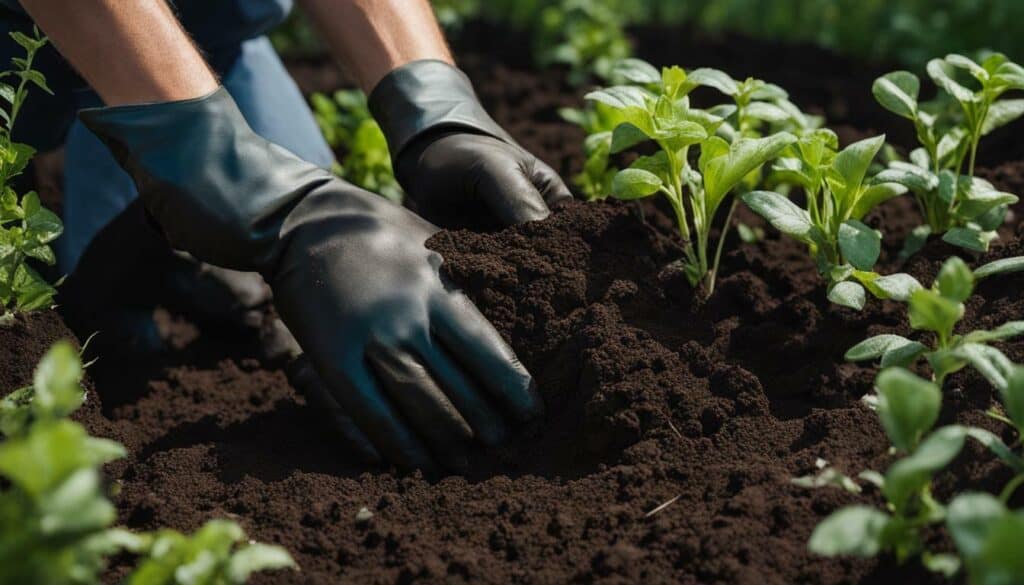
The Importance of Weeding
Weeding is a vital aspect of plant gardening and plays a significant role in maintaining a healthy and productive garden. It involves removing unwanted plants, known as weeds, from your garden bed. This process is crucial for several reasons.
Firstly, weeds compete with your desired plants for essential resources such as water, sunlight, and nutrients. By removing weeds, you ensure that your plants have access to the necessary resources for their growth and development.
Weeds can also harbor pests and diseases that can negatively impact the health of your garden. By removing weeds, you reduce the chances of these pests and diseases spreading to your desired plants.
Weeding also helps to maintain the aesthetic appeal of your garden. Weeds can give a messy and unkempt appearance to your garden, while well-maintained and weed-free beds create a neat and organized look.
Regular weeding is important in preventing weeds from going to seed and spreading throughout your garden. Weeds can reproduce quickly and produce large quantities of seeds, leading to an increase in weed populations if left unchecked.
To effectively weed your garden, it is important to remove both the plant and its root system to prevent regrowth. There are various methods of weed removal, including hand pulling, hoeing, and mulching. The method you choose depends on the type of weed and the size of your garden.
Implementing a regular weeding schedule and staying on top of weed control will save you time and effort in the long run. By keeping your garden free from weeds, you ensure that your plants have the best chance to thrive and flourish.
In conclusion, weeding is a vital aspect of gardening that should not be overlooked. It helps to maintain the health and appearance of your garden, prevent pest and disease infestations, and ensure the success of your desired plants. By dedicating time and effort to regular weeding, you can create a beautiful and thriving garden.
Harvesting Your Plants
After all your hard work, it’s time to reap the rewards of your plant gardening efforts. Harvesting your plants is a crucial step in plant gardening, and it requires proper techniques and knowledge to ensure optimal results. Before harvesting, it’s important to choose the right plants for your garden, ensuring they thrive in the soil conditions, sunlight, and water levels of your garden.
Preparing the soil is also key to successful harvesting. Conduct a soil test to determine the nutrient levels and pH balance of your soil. If necessary, add soil amendments such as compost and organic matter to improve soil fertility and structure. Well-prepared soil yields healthy, robust plants.
When it comes to harvesting, pruning is essential to maintain plant health and productivity. Remove any dead or diseased branches to encourage new growth and prevent the spread of disease. Be sure to use the proper pruning tools, such as sharp shears and loppers, to avoid damaging the plant.
Another important step in harvesting is weeding. Weeds can interfere with plant growth and productivity by competing for nutrients and water. To prevent weed growth, it’s essential to remove them regularly. Mulching can also help retain moisture and suppress weed growth, making it a great addition to your gardening toolkit.
Finally, cleaning and maintaining your gardening equipment is vital for optimal garden care. Properly cleaned and stored equipment will last longer and perform better, saving you time and money in the long run.
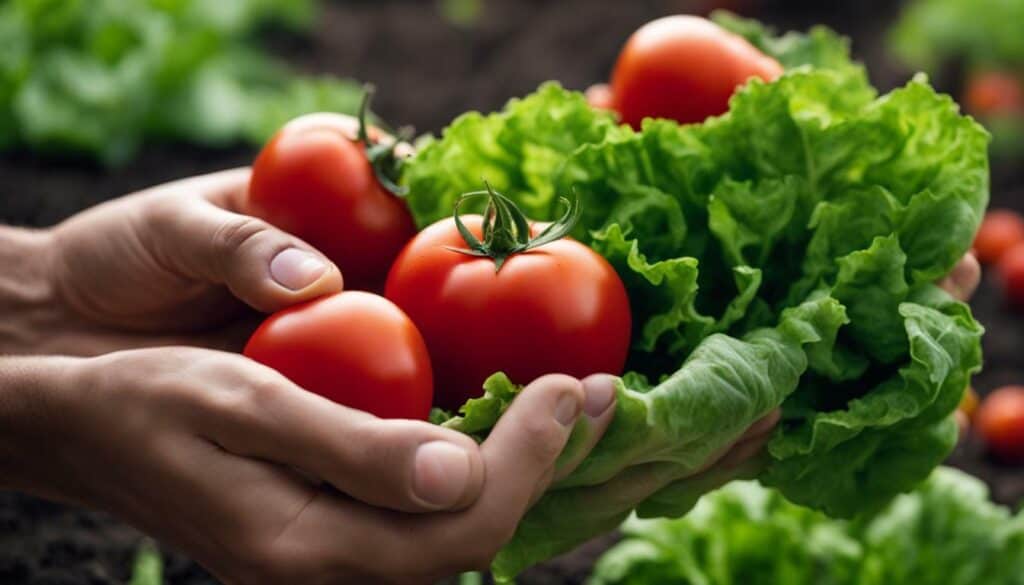
By following these tips, you can have a thriving garden and enjoy the benefits of plant gardening. With proper knowledge, techniques, and patience, you can grow healthy, delicious, and beautiful plants.
Conclusion
Plant gardening is a rewarding and fulfilling hobby that allows you to create beautiful, thriving green spaces both indoors and outdoors. With the right knowledge, tools, and passion, anyone can develop their green thumb and enjoy the benefits of plant gardening.
Begin by choosing the right plants for your garden and preparing the soil for optimal growth. Conduct soil testing and determine the correct soil amendments to ensure your plants receive the necessary nutrients. Proper maintenance and care, including watering, fertilization, pruning, and pest control, are crucial for the continued success of your garden.
By following these tips, you can create a stunning oasis that will bring joy and satisfaction throughout the growing season. So, get your gardening tools ready and enjoy the process of creating a green paradise in your own backyard.
Start your plant journey today and watch your garden flourish!
FAQ
Q: What are some basic gardening tips for beginners?
A: Basic gardening tips for beginners include choosing the right plants, preparing the soil, watering techniques, and pest control.
Q: How do I choose the right plants for my garden?
A: Consider factors such as sunlight, soil type, climate, and personal preferences when selecting plants for your garden.
Q: How do I prepare the soil for planting?
A: Prepare the soil by removing weeds, loosening it with a garden fork, and incorporating organic matter such as compost or aged manure.
Q: What maintenance tasks are important for plant care?
A: Proper fertilization, pruning, and pest control are important maintenance tasks for plant care.
Q: What are some important spring garden jobs?
A: Pruning, weeding, mulching, planting, and cleaning and maintaining gardening equipment are important garden jobs for the spring season.
Q: What tools do I need for plant gardening?
A: Essential gardening tools include a trowel, pruners, garden gloves, a watering can or hose, and a garden fork or spade.
Q: Why is weeding important in gardening?
A: Weeding is important in gardening to prevent competition for nutrients and reduce the risk of pests and diseases.
Q: When and how should I harvest my plants?
A: Harvest plants when they are mature and follow specific guidelines for each plant type, such as harvesting leafy greens before they bolt.
What Are Some Essential Tips for Home Gardeners?
Looking for an introduction to home gardening? Here are a few essential tips to get you started. First, consider your climate and choose plants accordingly. Provide adequate sunlight and water to make sure your garden thrives. Plan and organize your space efficiently, using raised beds or containers if you have limited room. Regularly weed and fertilize your plants for optimal growth. Lastly, keep learning and experimenting to improve your gardening skills.
Source Links
- https://arrows-uk.com/5-garden-jobs-to-tackle-this-season/
- https://www.thegoodlifeonstage.com/unleash-your-green-thumb-beginners-guide-to-gardening.htm
- https://www.shape.com/lifestyle/mind-and-body/find-your-green-thumb-first-time-gardening-tips
- https://www.greenthumb.com/unleashing-the-potential-of-small-spacesurban-gardening-in-southern-california/
- https://www.gardeningknowhow.com/garden-how-to/info/beginners-guide-to-gardening.htm
- https://www.almanac.com/vegetable-gardening-for-beginners
- https://www.bhg.com/gardening/yard/garden-care/ten-steps-to-beginning-a-garden/
- https://www.trentcompanies.com/wp-content/uploads/2015/04/Trent-Companies-Care-Guide.pdf
- https://extension.psu.edu/care-and-maintenance-of-perennials
- https://extension.okstate.edu/fact-sheets/basic-plant-care-understanding-your-plants-needs.html
- https://www.provenwinners.com/learn/early-spring/10-essential-spring-gardening-tasks
- https://www.hellomagazine.com/homes/20220224133929/garden-jobs-to-do-before-spring/
- https://www.gardeningetc.com/advice/spring-garden-jobs
- https://ag.umass.edu/landscape/fact-sheets/right-plant-right-place-plant-selection-guide-for-managed-landscapes
- https://www.realhomes.com/advice/how-to-choose-plants-for-your-garden
- https://www.fromhousetohome.com/garden/pick-the-right-plants/
- https://www.gardendesign.com/how-to/tools.html
- https://www.almanac.com/gardening-tools-guide
- https://www.washingtonpost.com/home/2023/02/28/essential-garden-tools/
- https://www.almanac.com/soil-preparation-how-do-you-prepare-garden-soil-planting
- https://www.homedepot.com/c/ai/how-to-prepare-soil-for-a-garden/9ba683603be9fa5395fab90dd5b2e0e
- https://platthillnursery.com/best-tips-to-prepare-garden-soil/
- https://gardening.stackexchange.com/questions/59594/how-true-is-the-idea-that-weeding-your-vegetable-garden-is-necessary
- https://www.smilinggardener.com/organic-pest-control/benefits-of-weeds/
- https://www.adirondackalmanack.com/2009/07/the-importance-of-weeding.html
- https://hgic.clemson.edu/factsheet/harvesting-vegetables/
- https://www.gardenary.com/blog/the-importance-of-harvesting-regularly-from-your-garden-in-the-summer
- https://www.gardeningknowhow.com/edible/vegetables/vgen/harvesting-for-beginners.htm
- https://sites.google.com/a/hanalani.org/growing/conclusion
- https://growingourown.wordpress.com/6-conclusion/
- https://grownextgen.org/download/student-research/the-effect-of-soil-on-plant-growth/sciencefairconclusionorzechowski.pdf


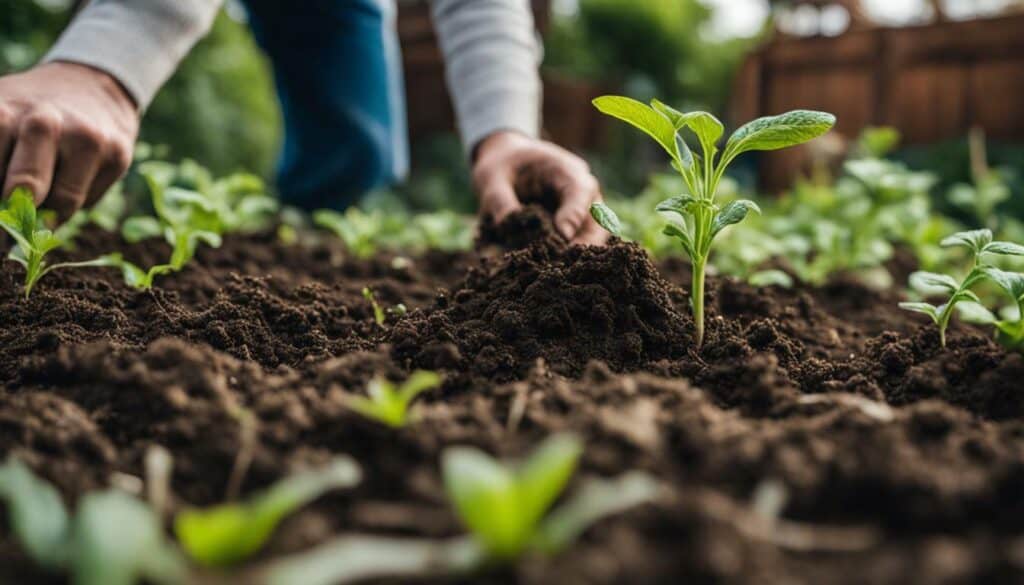



Leave a Reply